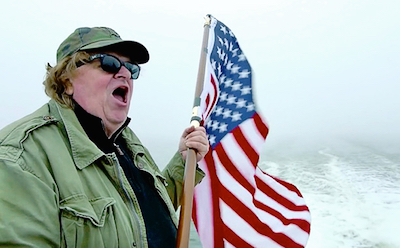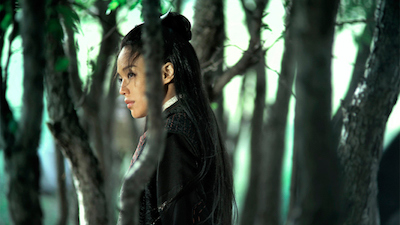 A few years ago Alice Tully Hall, home to the New York Film Festival, put in a restaurant as part of a makeover. The entrees include a savory chive popcorn, which is meant to be eaten before or after shows. Last Friday night, it happened–some millennial, not having received the message, took a bag inside the hall during a screening of The Assassin, and munched away.
A few years ago Alice Tully Hall, home to the New York Film Festival, put in a restaurant as part of a makeover. The entrees include a savory chive popcorn, which is meant to be eaten before or after shows. Last Friday night, it happened–some millennial, not having received the message, took a bag inside the hall during a screening of The Assassin, and munched away.
A little furtively, I should add; I think he noticed that no one else was snacking. But, still, every few minutes, his hand reached into the bag, which sent the fragrance of chives into the air. A fragrance that, for prim and proper elder audience members like me, who have been attending the festival since before he was in diapers, was like the smell of farts in church. Dude, it’s just not done.
Such shocking behavior is the natural outgrowth of a selection committee that in recent years has begun to smile upon “popcorn” filmmakers. Brian De Palma has had two films in recent festivals, Redacted (2007) and Passion (2012), and was this festival represented by an affectionate documentary, De Palma, co-directed by fans Noah Baumbach and Jake Paltrow. Steven Spielberg, whose Lincoln (2012) showed as a special event, was on hand this year, along with stars Tom Hanks and Mark Rylance, for a screening of Bridge of Spies.
And that’s fine. I wish some of their movies were better, but the acknowledgment that cinema doesn’t just live and breathe in the art house is overdue. The New York Film Festival doesn’t have the competitive and bazaar aspects of its larger brethren, giving it a more cloistered, insular, chive popcorn-free air. And it’s not that stuffy–my first festival, in 1994, had Ed Wood and Pulp Fiction as selections. Still, for years, it felt like the same names were being drawn each year from an approved pool of indie and foreign filmmakers, giving the festival a certain sameness as I sat down with my schedule, a mass of mailed papers in 1994, streamlined to online twenty years later.
 The embrace of Robert Zemeckis was a jolt. Once beloved for anarchic comedies like Used Cars (1980) and the head-spinning Back to the Future (1985). his name was mud with cinephiles after Forrest Gump, yet there he was at the festival three years ago with the bumpy, if well-crafted, Flight. Not just here this year, his latest, The Walk, launched the event. It was a sensible choice, too, a valentine to New York, and old school filmmaking chops and contemporary technical wizardry, that the selection committee was smart to open.
The embrace of Robert Zemeckis was a jolt. Once beloved for anarchic comedies like Used Cars (1980) and the head-spinning Back to the Future (1985). his name was mud with cinephiles after Forrest Gump, yet there he was at the festival three years ago with the bumpy, if well-crafted, Flight. Not just here this year, his latest, The Walk, launched the event. It was a sensible choice, too, a valentine to New York, and old school filmmaking chops and contemporary technical wizardry, that the selection committee was smart to open.
As is often the case, the largest and most receptive audiences for the movie were at Alice Tully; The Walk hasn’t exactly run in wide release. More’s the pity–it’s an exhilirating entertainment, not perfect, but mostly a joy to watch. Granted that I’m its perfect audience. At age 9, I thrilled to the breathless news coverage of Philippe Petit’s crossing of the Twin Towers that August day in 1974, and the Oscar-winning documentary Man on Wire (2008) has no bigger fan. It wouldn’t seem as if a feature film could any more with the story than James Marsh’s retelling did, and to some extent that’s true–The Walk bogs down in midsection, unable to bring Petit’s rogue’s gallery of helpers to life as thoroughly as the documentary. Yet it does something Man on Wire couldn’t do–it gives us the walk, recreated with astonishing verisimilitude and craft. In 3D, on the biggest screen you can find, I have no words. I’ve read reports of audiences sickening as Petit takes his first immortal steps through wisps of clouds, but that’s not Zemeckis’ fault–there’s no assaultive shaky cam up there on the wire, and the film, which draws us in deep to Petit’s death-defying artistry in Paris and New York, has only two “pop out” effects (two excellent ones). In the company of the perfectly adorable Joseph Gordon-Levitt, playing the perfectly adorable Petit, I left The Walk refreshed, delighted, inspired.
 How strange that was at the New York Film Festival, whose selections so often leave me depressed and anxious, my head spinning with subtitles, and hungry from so much austerity in theme and artistry. Michael Moore was back, with his first feature in six years, Where to Invade Next, and I braced myself for another sharp stick to the ribs, with a righteous leftist critique. Even when I agree with him, he often exasperates me, and by midway through this barnstorming through Europe and Tunisia, when he elaborates every single woman making a difference across the Atlantic–well, I suspect even the most ardent feminists were hoping he’d get on with the show. Despite the strident title, however, this is a movie that disarms with its basic sweetness, and positivity. What Moore (who trekked a similar hostel circuit when he was younger) finds in European health care, sex education, incarceration, and equal and civil rights is America, an America that has let these values wither through politicization. Other countries have run with them, successfully. (I believe some of the Tunisians interviewed just won the Nobel Prize.) Moore’s rosy assessments can be picked apart, and will be (and have been already). For now, I didn’t mind sinking into the warm bath of optimistic possibilities Moore has prepared for us.
How strange that was at the New York Film Festival, whose selections so often leave me depressed and anxious, my head spinning with subtitles, and hungry from so much austerity in theme and artistry. Michael Moore was back, with his first feature in six years, Where to Invade Next, and I braced myself for another sharp stick to the ribs, with a righteous leftist critique. Even when I agree with him, he often exasperates me, and by midway through this barnstorming through Europe and Tunisia, when he elaborates every single woman making a difference across the Atlantic–well, I suspect even the most ardent feminists were hoping he’d get on with the show. Despite the strident title, however, this is a movie that disarms with its basic sweetness, and positivity. What Moore (who trekked a similar hostel circuit when he was younger) finds in European health care, sex education, incarceration, and equal and civil rights is America, an America that has let these values wither through politicization. Other countries have run with them, successfully. (I believe some of the Tunisians interviewed just won the Nobel Prize.) Moore’s rosy assessments can be picked apart, and will be (and have been already). For now, I didn’t mind sinking into the warm bath of optimistic possibilities Moore has prepared for us.
 Speaking of baths–Guy Maddin’s latest jape, The Forbidden Room, has the poet John Ashbery telling us how to bathe, then sinks below the drain to find a submarine whose desperate mariners are using the air bubbles in their hated daily pancakes to survive. Several storylines are thrust at us, as Maddin and co-director Evan Johnson recreate (or, rather, create) madcap snippets of lost films, then jumble them up, finally hurling them at one another for a grandly apocalyptic climax. I say “finally” with relief, as two hours of distressed color washes, decayed-looking film stocks, and garbled soundtracks and intertitles are too, too much of a good thing. I was intrigued, then restless, then tickled anew by some weird element, like the chattering, vampiric Filipino banana monsters, who, properly exploited, could turn out to be the art house/avant garde equivalent of the Minions. Familiar faces like Mathieu Almaric, Charlotte Rampling, and Udo Kier are along for the ride, which, for a stretch, I couldn’t wait to see end. Not long after The Forbidden Room concluded, however, I wanted to see it again.
Speaking of baths–Guy Maddin’s latest jape, The Forbidden Room, has the poet John Ashbery telling us how to bathe, then sinks below the drain to find a submarine whose desperate mariners are using the air bubbles in their hated daily pancakes to survive. Several storylines are thrust at us, as Maddin and co-director Evan Johnson recreate (or, rather, create) madcap snippets of lost films, then jumble them up, finally hurling them at one another for a grandly apocalyptic climax. I say “finally” with relief, as two hours of distressed color washes, decayed-looking film stocks, and garbled soundtracks and intertitles are too, too much of a good thing. I was intrigued, then restless, then tickled anew by some weird element, like the chattering, vampiric Filipino banana monsters, who, properly exploited, could turn out to be the art house/avant garde equivalent of the Minions. Familiar faces like Mathieu Almaric, Charlotte Rampling, and Udo Kier are along for the ride, which, for a stretch, I couldn’t wait to see end. Not long after The Forbidden Room concluded, however, I wanted to see it again.
 I may very well revisit The Assassin when it begins a commercial run this Friday. Partly to sort out the plot, the story of a female killer (Shu Qi, who you may recall from The Transporter) in ninth-century China, whose somewhat arcane personal issues get in the way of her work, which is offing corrupt officials (I got the gist, anyway.) But mostly to enjoy some incredible visuals–cinematography, costuming, music, and all the filmic arts are at the highest level. It seems like every director in the vicinity of China is obliged to make a wuxia, but I never thought we’d see one from Taiwan’s Hou Hsiao-hsien, a long-time festival mainstay who didn’t seem the type. My bad–Hou has infused the genre with his stillness, his tension, and his grace. When the blood-letting comes, in swift, deliberate moves that pierce long takes and formally arranged tableaus, you’re left reeling by an old master who you only thought you knew. While I prefer you don’t, for the sake of festival etiquette and Lincoln Center’s staff, who have to ready the auditorium quickly between shows–yes, you could eat popcorn to The Assassin.
I may very well revisit The Assassin when it begins a commercial run this Friday. Partly to sort out the plot, the story of a female killer (Shu Qi, who you may recall from The Transporter) in ninth-century China, whose somewhat arcane personal issues get in the way of her work, which is offing corrupt officials (I got the gist, anyway.) But mostly to enjoy some incredible visuals–cinematography, costuming, music, and all the filmic arts are at the highest level. It seems like every director in the vicinity of China is obliged to make a wuxia, but I never thought we’d see one from Taiwan’s Hou Hsiao-hsien, a long-time festival mainstay who didn’t seem the type. My bad–Hou has infused the genre with his stillness, his tension, and his grace. When the blood-letting comes, in swift, deliberate moves that pierce long takes and formally arranged tableaus, you’re left reeling by an old master who you only thought you knew. While I prefer you don’t, for the sake of festival etiquette and Lincoln Center’s staff, who have to ready the auditorium quickly between shows–yes, you could eat popcorn to The Assassin.





Comments